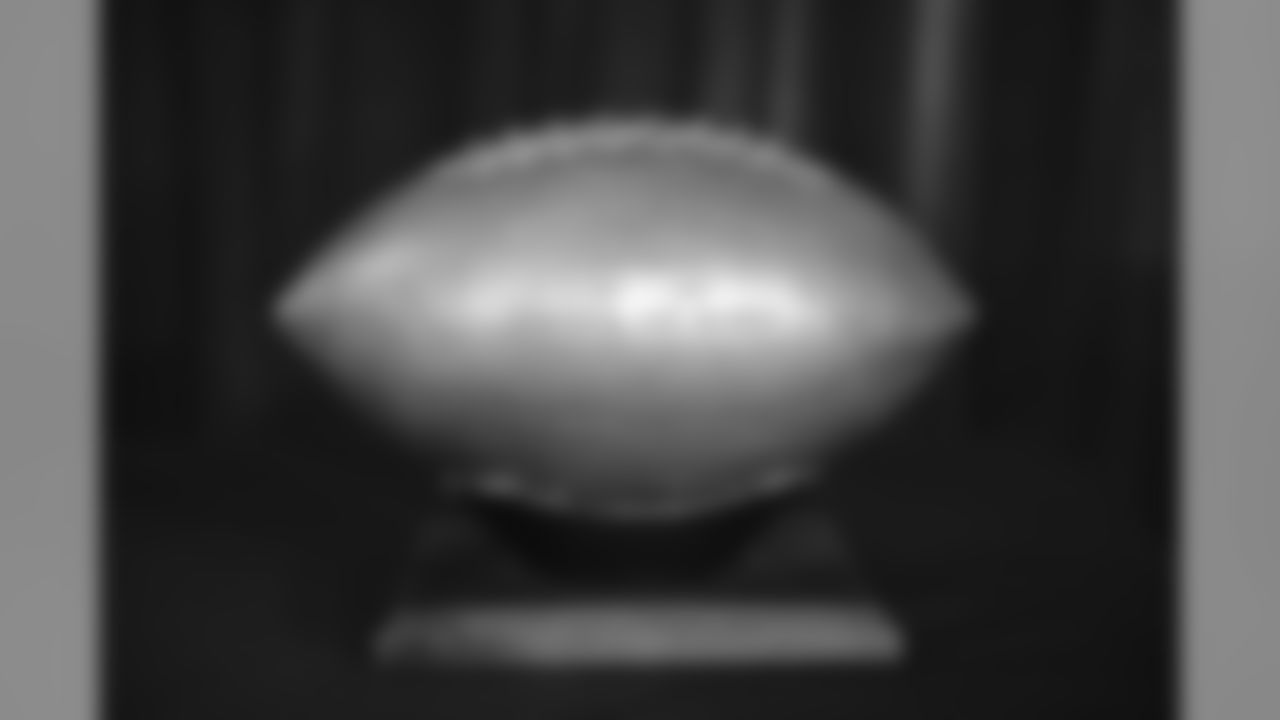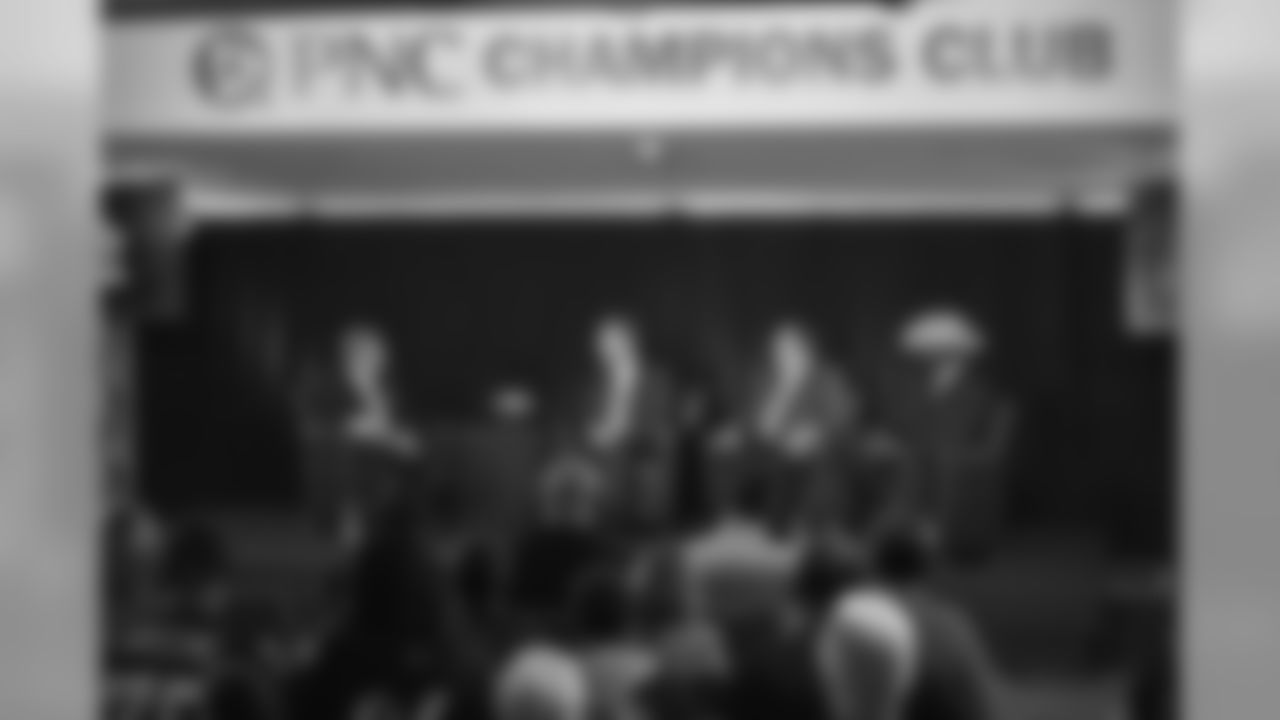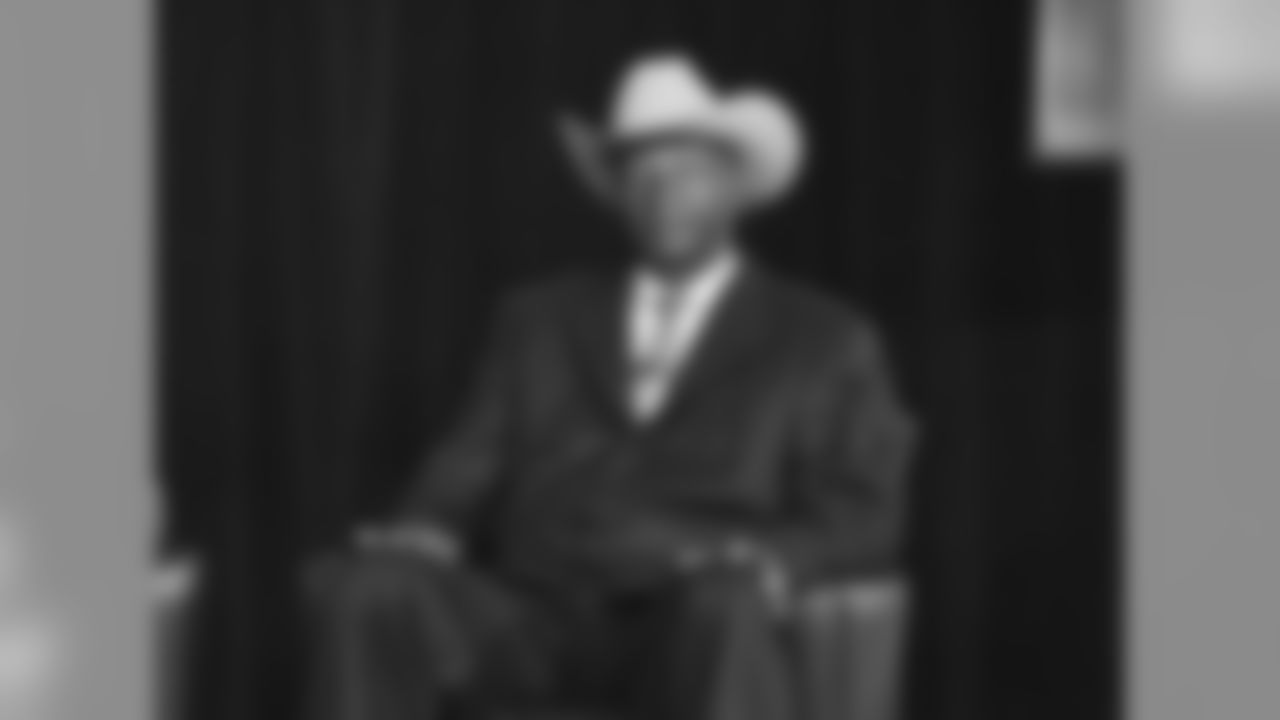When you think Steelers football, these are names that quickly come to mind.
And that is exactly why these 27 individuals, comprised of players, coaches and contributors, will make up the inaugural class of the team's Hall of Honor, which was revealed today at an event at the PNC Champions Club at Heinz Field.
The class includes in alphabetic order:
Jerome Bettis, Mel Blount, Terry Bradshaw, Jack Butler, Dermontti Dawson, Bill Dudley, Joe Greene, Kevin Greene, L.C. Greenwood, Jack Ham, Franco Harris, Dick Hoak, John Henry Johnson, Walt Keisling, Jack Lambert, Bobby Layne, John McNally, Chuck Noll, Arthur J. Rooney, Sr., Daniel M. Rooney, Andy Russell, Donnie Shell, John Stallworth, Ernie Stautner, Lynn Swann, Mike Webster, and Rod Woodson.
The Steelers announced 27 individuals who will comprise the Hall of Honor class.























"It is special. To have worked at a place and know your body of work gives you this kind of recognition is pretty special," said Mel Blount, who was on hand at the event to represent the Hall of Honor class. "Even more so, guys who maybe won't make it to Canton, but have made a great contribution to this organization. We wouldn't be in Canton without those guys. I think about Mike Wagner, Donnie Shell, L.C. Greenwood, great players, guys who were a part of that unit that made us all click. It's a special honor for me. I am humbled by it. I am excited not only for myself and my family, but for those players to come."
Blount, who joked that while he might not have seemed elated, he was, reflected on how the Steelers have grown since he was a rookie back in 1970.
"To see where this organization has come from 1970 when I came, to see where they are now, it takes people," said Blount. "Chuck Noll always said it takes good people to build something. I am excited. I feel honored to be a part of that journey, to see where the Steelers have come from, to see where they are. I know with the leadership of Art they will continue to climb. This is going to be something special. This is going to add to the greatness of the Steelers.
"From a personal standpoint, being in the Steelers Hall of Honor is special to me. It's the guys I played with, guys who made a great contribution to the organization. It's like family."
The idea for the Hall of Honor came from Steelers President Art Rooney II, along with late Chairman Dan Rooney. The Hall of Honor was established to recognize former players, coaches, and front office personnel who played an integral role in the success of the franchise, from the beginning in 1933 until now. To be considered, a player must be retired at least three years and played a minimum of three seasons for the Steelers. Former coaches and contributors had to make significant contributions to the team and community.* *The Hall of Honor Selection Committee consists of Steelers President Art Rooney II, Joe Gordon, Bob Labriola, Stan Savran, and Tony Quatrini.
"Some people would say it was a long time coming, and maybe overdue," said Rooney. "It's a recognition that we are so fortunate to have so many great players down through the years, coaches and other members of the organization. They aren't all going to be able to be recognized in Canton. This is our way of saying these guys deserve to be recognized.
"We fortunately have a long list of players who can be considered and will be considered. It was tough to narrow that list down and select the four that are added to the group from Canton this year. I know for the next few years at least it's going to be tough to keep picking and limiting ourselves to two or four a year. We really wanted to get started and recognize a lot of great players and coaches. You think of Dick Hoak and all of the years he spent in the organization. People like that deserve to be recognized and that is why it is so exciting to do this."
The 27-member class will be formally inducted into the Hall of Honor during the team's Alumni Weekend held Nov. 25-26, and they will be introduced during halftime of the Steelers-Packers game that Sunday. All will be presented with a steel football, a replica of one presented to Art Rooney Sr. by the U.S. Steel Corporation at the team's 50th Season celebration.
The Inaugural Hall of Honor ClassJerome BettisRunning Back (1996-2005)
Elected to Pro Football Hall of Fame: 2015
Jerome Bettis became the fourth Steelers' running back in the Hall of Fame joining Bill Dudley, John Henry Johnson and Franco Harris, who has been a fan of Bettis' since day one.
"He had a brilliant career, made big plays and was a big factor in the run the Steelers had," said Harris. "It's tough to last with the running style he had. Running backs don't last a long time. He ran tough and ran well."
Bettis was traded to the Steelers on draft day in 1996 from the Los Angeles Rams. Bettis rushed for 10,571 yards with the Steelers, and amassed 13,662 career yards, which puts him sixth overall in NFL history. Bettis was the Steelers leading rusher from 1996-2001 and in 2003-04, and he rolled up 50 100-yard games with the team. Bettis was voted to the Pro Bowl six times and was named first-team All-Pro twice.
Bettis capped his career in fairytale fashion when the Steelers won Super Bowl XL in Bettis' hometown of Detroit, and then he announced his retirement from the podium with the Lombardi Trophy in his hands.
Mel Blount
Cornerback (1970-83)
Elected to Pro Football Hall of Fame: 1989
There aren't many players who cause the NFL to change the rules because of their play, but there also aren't many players like Mel Blount.
Blount, the Steelers third round draft pick in 1970, came into the NFL with everything a coach would want…size, speed, quickness, mental and physical toughness..
Blount worked his way into the starting lineup in the 1972 season, not allowing a single touchdown all year. Blount's "bump-and-run" coverage later caused the NFL to implement the five-yard bump rule in 1977.
He had his best season in 1975 and was named Associated Press NFL Defensive Player of the Year, finishing the year with 11 interceptions. He finished his career with 57 interceptions and two touchdowns and 13 fumble recoveries with two touchdowns.
Blount was named All-Pro four times and played in five Pro Bowls. He was a key part of the Steelers success in the 1970s, starting and playing a key role in all four Super Bowls during that decade, and earning enshrinement into the Pro Football Hall of Fame.
Terry BradshawQuarterback (1970-83)
Elected to Pro Football Hall of Fame: 1989
Terry Bradshaw was the No. 1 overall pick in the 1970 NFL Draft and he definitely lived up to the hype.
Bradshaw led the team to four Super Bowl championships, being named MVP in Super Bowl XIII and XIV. He passed for 932 yards and nine touchdowns in the four Super Bowl victories and in 19 postseason games passed for 3,833 yards.
"He had the ability to throw the football," said his late Coach Chuck Noll. "He had the ability to run with it when he had to. He had all kinds of physical abilities, and it was just a question of being able to use that on the field. Terry, without a question, wanted to be the best. Terry worked at it very hard, both physically and mentally, and spent time in the classroom, and on film, and prepared himself very well."
He was also named the NFL's Most Valuable Player in 1978 when he completed 207 passes for 2,915 yards and 28 touchdowns.
He finished his career completing 2,025 passes for 27,989 yards and 212 touchdowns.
Jack Butler
Cornerback (1951-59)
Elected to Pro Football Hall of Fame: 2012
Jack Butler, a Pittsburgh native, joined the Steelers in 1951 as a free agent out of St. Bonaventure. He played in 103 games at cornerback in his nine seasons, recording 52 interceptions that helped earn him a spot in the Pro Football Hall of Fame as one of the Senior Committee nominees.
Butler was selected to the NFL's All-Decade Team of the 1950 and when he retired he was second on the NFL's all-time list with 52 interceptions. Butler had four interception returns for a touchdown and had one fumble recovery for a touchdown. He returned his first career interception 52 yards for a touchdown.
"He was the perfect guy for a defensive back in those days," said former teammate Ted Marchibroda. "He did not have the greatest speed, but he had good speed, good, good size, good hands and his instincts were tremendous. Jack worked at his profession in those days; most guys didn't work as hard as he did."
After his retirement from the Steelers, Butler went on to a career in scouting, and served as the executive director for BLESTO.
Dermontti Dawson
Center (1988-2000)
Elected to Pro Football Hall of Fame: 2012
It's not often a player comes along who has the ability to redefine the way a position is played.
But Dermontti Dawson did just that.
"What Dermontti did, which is what Mel Blount did, was change the game," said former Steelers running back Merril Hoge. "You never had a center pull until Dermontti Dawson. He revolutionized and changed how teams ran the football in the NFL. I played with Mike Webster in my first year with the Steelers, and I never thought I would be able to say someone was better than Mike Webster at center. But Dermontti changed how we ran the ball."
Dawson was drafted by the Steelers in the second round in 1988 from Kentucky. He played his entire 13-year career with the Steelers, and he took over for Webster at center in his second season and remained a dominant force at the position throughout his career.
Dawson, who played in 170 consecutive games, was a seven-time Pro Bowl selection and was a first-team All-Pro six times. He was also named to the NFL's Team of the Decade for the 1990s.
Bill DudleyHalfback (1942, 1945-46)
Elected to Pro Football Hall of Fame: 1966
Before Jerome Bettis, before Franco Harris, and before John Henry Johnson, there was a man who dominated in the backfield for the Pittsburgh Steelers – Bill Dudley.
Dudley, the Steelers first-round draft choice in 1942 who was nicknamed "Bullet Bill", set the standard for the backs that would come after him, despite being a small back at only 5-10, 182 pounds. He was the league's leading rusher his rookie year with 696 yards, earning him all-league honors. The next two years Dudley left football, serving in the United States Army Air Corps during World War II as a B-25 and B-29 pilot in the Pacific.
But football was what he loved, so when he returned it was back to the Steelers during the 1945 season. Dudley's best season in a Steelers uniform came in 1946 when he was named the NFL's Most Valuable Player while leading the league in rushing (604), punt returns (27), and interceptions (10).
Joe GreeneDefensive Tackle (1969-81)
Elected to Pro Football Hall of Fame: 1987
Joe Greene changed what it meant to play for the Pittsburgh Steelers. He changed the mindset of those who wore the black and gold, starting with his teammates in the 1970s, with his impact still lasting today.
Greene, the leader of the Steel Curtain defense for 13 seasons, the Hall of Fame defensive tackle who helped bring four Super Bowl championships to Pittsburgh, the two-time NFL Defensive Player of the Year, is the player who helped shape the franchise and he was honored for everything he did when his No. 75 was retired in 2014, only the second number in franchise history ever to be retired.
Greene was selected to the Pro Bowl 10 times, including eight straight years from 1969-76. He was a five-time first-team All-Pro selection, 11-time first-team All-AFC selection, NFL Defensive Player of the Year twice (1972 and 1974) and NFL Defensive Rookie of the Year in 1969. He was named to the NFL's 75th Anniversary All-Time Team, the 1970s All-Decade Team and the Steelers 75th Anniversary All-Time Team. He was also the NFL Defensive Player of the Year in 1974.
Kevin Greene
Linebacker (1993-95)
Elected to Pro Football Hall of Fame: 2016
Kevin Green signed with the Steelers a free agent in 1993, and spent three of his 12 seasons in black and gold, wreaking havoc on opposing quarterbacks.
Greene, who was originally drafted by the Los Angeles Rams, finished his career with 160 sacks, 26 fumble recoveries, five interceptions, and recorded three safeties. He had double-digit sacks 10 times in his 15 seasons, and he led the NFL in sacks in 1994 (14.0) and 1996 (14.5). He was named to the NFL's All-Decade Team of the 1990s. He was a three-time first-team All-Pro and a five-time Pro Bowler and enshrined into the Pro Football Hall of Fame.
During his three seasons with the Steelers (1993-95) he recorded 35 ½ sacks, the second most by a player in their first three seasons with the Steelers since sacks became an official statistic in 1982.
"I loved getting a sack," said Greene. "A sack was different than making a tackle for a loss, or a tackle at the line of scrimmage. It was just me making a contribution and not letting my brothers down."
L.C. Greenwood
Defensive End (1969-81)
Jack Ham remembers it well, still.
It was in 1976, when the Steelers defense was so dominant that it forced rules changes, and the team had a game in Kansas City. So dominant were the defensive linemen on his side of the field – Joe Greene at left tackle and L.C. Greenwood at left end – that he, as the left outside linebacker, went through most of the entire first half without being touched.
Picked on the 10th round by the Steelers from Arkansas AM&N, Greenwood was too slight to play for many teams, but Chuck Noll and line coach Dan Radakovich nurtured his athleticism. Recognized for the gold high-top cleats he wore, Greenwood was known as a big-game player. From 1973-75 he had 25.5 sacks; in Super Bowl IX he batted down three passes; and in Super Bowl X he sacked Roger Staubach three times. He is ranked second on the team's all-time sacks list with 73.5.
Jack Ham
Linebacker (1971-82)
Elected to Pro Football Hall of Fame: 1988
The Steelers selected Jack Ham in the second round of the 1971 NFL Draft and the consistent, steady linebacker played his entire 12-year career in the black and gold.
Ham earned a starting job right out of the gate at left outside linebacker as a rookie and held onto the starting role through his entire career, showing his durability by missing only four games in his first 10 seasons.
Ham was named the Football News Defensive Player of the Year in 1975, and was selected to eight straight Pro Bowls. He was named All-Pro six times and All-AFC seven times and elected to the Pro Football Hall of Fame.
Ham, who played in five AFC Championship games, was a key component during the team's Super Bowl years in the 1970s. He finished his career with 25 sacks, 21 fumble recoveries and 32 interceptions to his credit. The combined 53 takeaways are the most ever by a non-defensive back. He was also named to the NFL's 75th Anniversary Team, the NFL All-Time Team, the Steelers 75th Anniversary Team and the NFL's Team of the Decade for the 1970s. Ham also earned a spot on the coveted Hall of Fame 50th Anniversary Team.
Franco HarrisRunning Back (1972-83)
Elected to Pro Football Hall of Fame: 1990
Franco Harris will forever be remembered for the greatest play not just in Steelers' history, but one recognized by many as the greatest play ever in NFL history, the "Immaculate Reception," in the 1972 AFC Divisional Playoff Game vs. the Oakland Raiders at Three Rivers Stadium,
That play was just the start for Harris, the Steelers first-round draft selection in 1972, the 13th pick overall, who finished his rookie year with 1,055 yards rushing and 10 touchdowns.
Harris carried the load for the team for 12 seasons, and is the team's all-time leading rusher with 11,950 yards and leads with 91 rushing touchdowns. He finished his career with 12,120 yards after spending his final season in Seattle.
He had eight 1,000-yard seasons, and rushed for at least 100 yards in 47 games. Harris added 307 receptions for 2,287 yards. Harris was a member of four Super Bowl championship teams, winning MVP honors for Super Bowl IX when he rushed for 158 yards in a 16-6 win over the Minnesota Vikings. He also was named to the Pro Bowl nine times, was All-AFC four times, and was enshrined in the Pro Football Hall of Fame.
Dick HoakPlayer (1961-70)*Coach (1972-2006) *Dick Hoak retired in 2006 after serving the Steelers for 45 seasons as a player and an assistant coach. As a player, he wasn't as good as some of the guys he coached, and as a coach he never ascended above the rank of position coach.
That's one way to paint Hoak's career, but here's another: As a player and an assistant coach, Dick Hoak was an egoless part of the team, a man who did his job quietly but with intensity. He was loyal to the point of forsaking his own advancement to honor a commitment he believed he had made; he was more interested in winning than he was in being right; and he was way more interested in winning than he was in getting the credit.
Still seventh on the franchise's all-time rushing list with 3,965 yards, Hoak accumulated that total on teams that posted a combined 46-88-6 record. Hoak also coached Hall of Fame running backs Franco Harris and Jerome Bettis, and he turned down the head coaching job of the USFL's Pittsburgh Maulers because he believed that accepting it would be disloyal to the Rooneys.* *"I just couldn't see myself going across the street to a rival football league in Pittsburgh. There was no way I could have done that."
John Henry Johnson
Fullback (1960-65)
Elected to Pro Football Hall of Fame: 1987
John Henry Johnson was the Steelers second pick in the 1953 NFL Draft, but he didn't play for the Steelers immediately, going to the CFL, and then becoming the property of other NFL teams because of that. Johnson was acquired by the Steelers via trade in 1960, where he would spend the most productive six seasons of his career.
Johnson carried the ball 118 times for 621 yards and two touchdowns in 1960, and added 213 carries for 787 yards and six touchdowns his second season. It was in 1962 that he would become the first Steelers player to rush for more than 1,000 yards, with 251 carries for 1,141 yards and seven touchdowns. He eclipsed the 1,000 yard mark again in 1964 with 235 carries for 1,048 yards. He finished his Steelers days with 4,383 yards and three Pro Bowl selections.
Johnson finished his career with the AFL's Houston Oilers in 1966, and walked away with 6,803 career rushing yards, fourth all-time behind Jim Brown, Jim Taylor and Joe Perry at the time, and was enshrined into the Pro Football Hall of Fame.
Walt Kiesling*
*Player (1937-39), Coach (1939-44, 1954-56)
Elected to Pro Football Hall of Fame: 1966
Once his NFL playing days ended, Walt Kiesling stayed right where he spent the previous three years as a player, in Pittsburgh but this time as a coach.
Kiesling played guard on offense and defense during his playing years, and dominated games as he was considered to be stronger and tougher than most of the players he went against. Kiesling, who was named to the NFL's all-league team in 1929, 1930 and 1932, played in Pittsburgh from 1937-39.
Kiesling's joined Johnny 'Blood' McNally to be a head coach in 1939 when the team was known as the Pirates, and continued in that role as the team changed their name to the Steelers in 1940. In 1942 Kiesling lead the Steelers to their first winning season in franchise history, finishing 7-4. He co-coached the Pittsburgh-Philadelphia and Pittsburgh-Chicago Cardinals combined teams during World War II. Kiesling left coaching for a time after the 1944 season, but returned in 1954 for a three-year stint with the Steelers.
Jack Lambert
Linebacker (1974-84)
Elected to Pro Football Hall of Fame: 1990
He was one of the most menacing linebackers ever to play in the NFL, known fondly as "Jack Splat" or "Dracula in Cleats."
"We're the Pittsburgh Steelers. We're supposed to be the intimidators," Lambert once said.
Lambert, the Steelers second-round pick in the legendary 1974 NFL Draft class, won the starting middle linebacker job his rookie year and held on to it for his 11-year career.
He won the NFL's Defensive Rookie of the year that season, and two years later was named the NFL's Defensive Player of the Year and became known as one of the premier linebackers of his era, with a combination of intelligence, intensity, speed and range. Lambert was named to nine straight Pro Bowls, was All-Pro eight times, and a team defensive captain for eight years. He played in six AFC Championship games and was a member of the Steelers four Super Bowl winning teams in the 1970s. Lambert had 28 career interceptions, including a pivotal one late in Super Bowl XIV that secured the win.
Bobby Layne
Quarterback (1958-62)
Elected to Pro Football Hall of Fame: 1967
Bobby Layne was originally drafted by the Steelers, but quickly traded away. Fate brought Layne to the Steelers for the final years of his career, 1958-62, where he brought his leadership and competitiveness to a team that needed it. Lions coach Buddy Parker left the team in 1957 to coach the Steelers, and the following year the Steelers acquired Layne via a trade in October. The two combined for what would be the Steelers best year to date.
In his first full season with the Steelers Layne completed 142 passes for 1,986 yards and 20 touchdowns. He followed that with passing for 1,814 yards and 13 touchdowns in 1960, 1,205 yards and 11 touchdowns in just eight games in 1971 and 1,686 yards and nine touchdowns in 1962, his final season.
Layne finished his amazing career with 1,814 completions for 26,768 yards and 196 touchdowns in 175 career games, but once stated his biggest disappointment in football was never winning a championship for Art Rooney Sr.
Johnny 'Blood' McNallyPlayer (1934, 1937-39), Coach (1937-39)
Elected to Pro Football Hall of Fame: 1963
Johnny 'Blood' McNally played four seasons in Pittsburgh, including three when he was a player-coach, during a time when the team was known as the Pittsburgh Pirates.
He was considered a vagabond and one of the most colorful players of his time, adopting the name Blood from the movie, 'Blood and Sand,' that starred Rudolph Valentino. He used it not as a nickname, but an alias to forgo his final year of eligibility at St. John's College and play pro ball with the East 26th Street Liberties of Minneapolis.
He played 14 seasons with five different teams, and had two stints in Pittsburgh. He played in 1934 and then returned to finish out his career from 1937-39. He played running back, receiver, punted, was used at quarterback and could play defense.
"They pay me to score touchdowns," he was quoted as saying. "The swagger I give 'em for free."
In his first game back in Pittsburgh in 1937 he returned the opening kickoff 92 yards for a touchdown, but the team struggled during his years with just a 7-25-1 record.
Chuck Noll
Coach (1969-91)
Elected to Pro Football Hall of Fame: 1993
Charles Henry Noll, "The Emperor," truly was the man who changed who the Pittsburgh Steelers were and continue to be.
When he was hired in 1969, the Steelers were a team that had struggled to win in the past. Even in his first season the team went just 1-13.
But it didn't take long for Noll to bring a culture of winning with his style of coaching. Under Noll the Steelers won four Super Bowl championships in a six-year span - Super Bowls IX, X, XIII and XIV. Noll led the Steelers to 15 winning seasons, nine division championships, and 12 playoff appearances, along with the four Super Bowl victories in the 1970s, and was enshrined into the Pro Football Hall of Fame.
Noll won 209 games in his 23 seasons with the Steelers, and coached 11 Pro Football Hall of Fame players. And he did it in a manner that is not often seen in sports.
"Chuck was just the ultimate leader," said Hall of Fame defensive lineman Joe Greene and Noll's first-ever draft pick. "He had truth and belief in what he was saying, and over time all of those things he said were validated, the things about winning football games and being a solid citizen."
Art Rooney Sr.
Founder, President, Chairman of the Board (1933-88)
Elected to Pro Football Hall of Fame: 1964
When you think of the Steelers, you think of the Rooney family, and it all began with Art Rooney Sr., affectionately known as 'The Chief.'
Rooney exemplified what the Pittsburgh Steelers were about from the time he founded the organization on July 8, 1933 and throughout the glory years of the 1970s when the team won four Super Bowl championships.
Rooney was a driving force behind the NFL-AFL merger, and kept the Steelers franchise viable during the depression, World War II and other tough times, even merging with the Philadelphia Eagles in 1943 and Chicago Cardinals in 1944 during the war.
"He was a man who belonged to the entire world of sports,'" said former NFL Commissioner Pete Rozelle. "It is questionable whether any sports figure was more universally loved and respected."
Rooney, who was presented for his Hall of Fame induction by former Pennsylvania Governor David Lawrence, handled his day in Canton with the same grace and humble approach he handled everything in life.
"I am indebted and grateful to the men that chose me for this great honor," said Rooney. "To the people of Pittsburgh and all the sports fans everywhere, I owe my thanks."
Dan Rooney Sr.
President and Chairman (1955-2017)
Elected to Pro Football Hall of Fame: 2000
Dan Rooney Sr. was one of the NFL's most influential owners and a pivotal figure in the growth and development of the league. Throughout the years Rooney has been a member of the board of directors for the NFL Trust Fund, NFL Films, and the Scheduling Committee. He was appointed Chairman of the League's Expansion Committee in 1973, eventually adding Seattle and Tampa Bay to the NFL in 1976.
Rooney was named Chairman of the Negotiating Committee in 1976, and in 1982 he contributed to the negotiations for the Collective Bargaining Agreement for NFL owners and the Players Association. He brought a calm, reasonable approach to labor relations, and was a driving force in the labor agreement again in 1993. Rooney has also been a member of the Management Council Executive Committee, the Hall of Fame Committee, the NFL Properties Executive Committee, and the Player/Club Operations Committee. Rooney was enshrined into the Pro Football Hall of Fame in 2000. He served as the President of the Steelers from 1975 until 2003, when he turned it over to his son, Art Rooney II, and became the Chairman until his passing in April, 2017.
He spearheaded what is known as the Rooney Rule in 2003, which required NFL teams to interview a minority candidate for head coaching and senior football operation jobs. Rooney also served as the United States Ambassador to Ireland.
Andy Russell
Linebacker (1963, 1966-76)
Wrote Jack Ham, "Today, most players back into the Pro Bowl by playing mediocre football on good teams. Andy played great football on a worse than mediocre team. Why? Because Andy was always the consummate professional. His personal pride and drive for excellence allowed him to stand out on even the worst of football teams. It would have been easy for him to give up or be sucked into the mediocrity that he saw all around him, but he refused to do so. That attitude was clear to me from my first day of training camp to Andy's last game with the Steelers."
From 1963-71, Russell played on a lot of Steelers teams that did a lot of losing, but he also was part of the dramatic turnaround that ended with back-to-back Super Bowl championships in 1974-75.
Russell played in 168 consecutive games during his NFL career with the Steelers. A 16th round draft pick from Missouri, Russell played in seven Pro Bowls and was voted team MVP in 1971.
Donnie Shell
Safety (1974-87)
Earl Campbell was a 233-pound running back by trade, and inflicting pain was part of his business. In 1978, Campbell would finish with 1,450 yards, a 4.8 average and 13 touchdowns, but on Dec. 3 with the division title at stake, he met his match in Donnie Shell. In the first quarter, Campbell was spinning out of a tackle trying to get extra yards, when the man nicknamed "Torpedo" came flying up to the line of scrimmage and delivered a blow that could be heard in the upper reaches of the Astrodome. Campbell left the game with a broken rib, and the Steelers beat the Oilers, 13-3, in a season that ended with the third Super Bowl championship in team history.
Shell was an undrafted rookie in 1974 because he played linebacker at South Carolina State, but through hard work and dedication he made himself into an All-Pro who finished his career with 51 interceptions, still the most in NFL history for a strong safety. Shell was a five-time Pro Bowl player, who had at least one interception in each of his 14 NFL seasons.
John Stallworth
Wide Receiver (1974-87)
Elected to Pro Football Hall of Fame: 2002
John Stallworth, the Steelers fourth-round selection in the historic Steelers 1974 NFL Draft class, caught 537 passes for 8,723 yards and 63 touchdowns, all Steelers team records at the time of his retirement. He also scored one rushing touchdown.
He played in six AFC championship games and was a part of the Steelers four Super Bowl championships and was named team MVP twice. Stallworth was named All-Pro in 1979, All-AFC in 1979 and 1984 and played in four Pro Bowls. He had 12 postseason touchdown catches and 17-consecutive postseason games with a reception.
Stallworth scored the game winning touchdown on a 73-yard reception in Super Bowl XIV against the Los Angeles Rams. Stallworth still holds the Super Bowl record for average yard per catch with 24.4 yards. He also holds the record for single-game average, 40.33 yards, set in Super Bowl XIV. Swann is second in that category with a 40.25 yard average from Super Bowl X, and Stallworth third with a 38.33 yard average in Super Bowl XIII.
Stallworth is currently a member of the Steelers ownership group.
Ernie Stautner
Defensive Tackle (1950-63)
Elected to Pro Football Hall of Fame: 1969
Ernie Stautner was the first player ever to have his number retired by the Pittsburgh Steelers, and it was well earned as he was the first of their Hall of Famers to play his entire career with the team. The team's second-round draft pick in 1950, Stautner's No. 70 was retired in 1964.
Stautner won the NFL's Best Lineman Award in 1957 and he earned All-NFL honors nine times and was selected to nine Pro Bowls, despite being considered undersized. He missed just six games during his 14-year career, never letting numerous injuries slow him down.
"That man ain't human. He's too strong to be human," Jim Parker, the Hall of Fame offensive guard for the Baltimore Colts once said. "He's the toughest guy in the league to play against because he keeps coming headfirst. Swinging those forearms wears you down.
"That animal used to stick his head in my belly and drive me into the backfield so hard that when I picked myself up and looked around, there was a path chopped through the field like the farmer had run a plow over it."
Lynn Swann
Wide Receiver (1974-82)
Elected to Pro Football Hall of Fame: 2001
Lynn Swann, the first-round draft pick in the legendary 1974 Steelers draft class, had plenty of opportunities to show his individual talent. Known for his graceful moves and leaping catches, Swann always came through on the big stage.
Swann, who suffered a concussion in the 1975 AFC Championship Game, was an uncertainty to be ready for Super Bowl X. But Swann was ready to go come game day, and then some.
He had four receptions for 161 yards and a 64-yard touchdown. But you have to see the highlight reel to truly appreciate the greatness of what he did, as the receptions are legendary footage for NFL Films courtesy of his circus catch and leaping ability. He went on to win MVP honors for his performance.
Swann finished his career with 336 receptions for 5,462 yards and 51 touchdowns, and a highlight reel that would make any receiver envious. Swann was named All-Pro and selected to the Pro Bowl in 1975, 1977 and 1978, and was named to the NFL's All-Decade Team of the 1970s and the Super Bowl Silver Anniversary Team.
Mike Webster
Center (1974-88)
Elected to Pro Football Hall of Fame: 1997
Mike Webster, a fifth-round draft pick by the Steelers in the famed 1974 NFL Draft, started 150 consecutive games, beginning at the end of the 1975 season and lasting until 1986, when a dislocated elbow sidelined him for four games.
Webster played 15 seasons and 200 games with the Steelers, more than any other player in team history. He spent his last two seasons (1989-90) with the Kansas City Chiefs.
He was the Steelers offensive captain for nine seasons, a strong leader off the field and the strongest player on the field, earning him the nickname "Iron Mike."
"Mike wasn't tall enough, he didn't weigh enough, but the thing he had that made the difference was he had great playing strength," said late Hall of Fame Coach Chuck Noll. "You could see it on the field. He would come off the ball with great quickness. He not only blocked well on the run, but he also pass protected well."
Webster, a member of the Steelers four Super Bowl championship teams in the 1970s, played in nine Pro Bowls, and was selected All-Pro seven times.
Rod WoodsonCornerback (1987-96)
Elected to Pro Football Hall of Fame: 2009
Rod Woodson played 10 of his 17 seasons in the NFL with the Steelers, after being selected by the team with their No. 1 pick in 1987.
He finished his illustrious career with 71 interceptions that he returned a total of 1,483 yards, including 12 of them for touchdowns. Woodson finished his career with 4,894 kickoff return yards, 2,362 punt return yards and five touchdowns on returns – two punts, two kickoffs and one fumble.
He was named to the Pro Bowl 11 times, selected as a cornerback, safety and a kick returner, and was enshrined into the Pro Football Hall of Fame.
Woodson earned NFL Defensive Player of the Year honors for his performance in 1993 when he recorded eight interceptions, returning one for a touchdown, 28 passes defensed, two forced fumbles and two sacks. Woodson, who had 38 interceptions with the Steelers, was named team MVP three times. He was one of only five active players named to the NFL's 75th Anniversary Team in 1994, and was also a member of the Steelers' 75th Anniversary All-Time Team.














